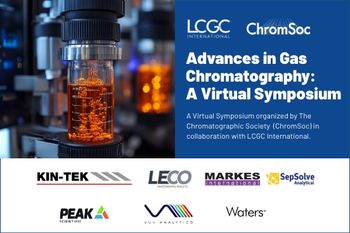
- Special Issues-07-01-2010
- Volume 8
- Issue 3
Ultralow Quantification of Pesticides in Baby Food
The safety of the food that our children eat is a global concern. Regulations are in place that limit the maximum level of pesticides that can be present in food meant for children, and methods to detect levels well below those limits are needed to ensure the safety of the food supply. Combining the speed and separation efficiency of ultrahigh-pressure liquid hromatography (UHPLC) with the sensitivity and selectivity of triple-quadrupole mass spectrometry (MS)-MS results in a method that can deliver ultralow quantification of pesticides in baby food, with limits of detection more than an order of magnitude below the allowed maximum levels.
Food production and distribution have become enormous international businesses, providing a cornucopia of foodstuffs, made possible in part by the 20th century development of pesticides. Crops that were previously devastated by pest damage can now be produced at very high yields to meet worldwide demand. However, all pesticide compounds are potentially harmful to humans, and there is currently an intense global focus on food safety, given recent events such as the contamination of milk with melamine. We no longer take it for granted that the food we eat is safe and free from contamination that could make us seriously ill, and safeguards must be in place to ensure that consumers are not exposed to dangerous levels of pesticides.
Children are most susceptible to pesticide contamination, since they eat a limited number of foods and their food intake relative to their weight is higher than that for adults, increasing their exposure to specific pesticides. Children may also absorb pesticides more easily and may be less capable of metabolizing these compounds. Pesticides can also block the absorption of nutrients vital to healthy growth and development.
Given the inordinate threat that pesticides pose to children, regulations have been enacted worldwide that establish limits for pesticides in baby food. The Food Quality Protection Act (FQPA) of 1996 provides special protection for infants and children. Under this mandate, the US Food and Drug Administration (FDA) performs regulatory monitoring by sampling individual lots of domestically produced and imported foods and analyzing them for pesticide residues to enforce established tolerances (
UHPLC–MS-MS for Ultralow Quantification
The combination of the new generation of triple-quadrupole mass spectrometry (MS) systems with ultrahigh-pressure liquid chromatography (UHPLC) systems facilitates the analysis of pesticides in challenging matrices, such as food samples, and can be particularly useful for analyzing sets of known target compounds. Multiple reaction monitoring (MRM) with a triple-quadrupole mass spectrometer provides detection of trace amounts of target compounds, enabling screening, confirmation, and quantification in one analysis. By choosing transitions that are characteristic for the pesticides of interest, chemical noise is separated from signal, providing very high sensitivity and selectivity, even in very dirty matrices. High sensitivity and scan rate capabilities make it possible to create an MRM assay that can be used to simultaneously identify and quantify a large set of pesticides in a sample. The high sensitivity is essential for the analysis of these compounds in derived products, where the concentrations will be a fraction of the concentration in the raw material.
UHPLC enables extremely fast and efficient separations, due to small particle size (<2 µm). A UHPLC system can provide a general increase in productivity, reduced method development time, more data from small samples, and a several-fold decrease in solvent usage and disposal costs, relative to conventional high performance liquid chromatography (HPLC). Particle size reduction generates a high back pressure (>400 bar) not compatible with conventional instrumentation. Combining a triple-quadrupole mass spectrometer with a UHPLC system with very low delay volumes that can sustain pressures as high as 1200 bar can deliver the sensitivity and specificity needed for the ultralow quantification of pesticides in baby food, with very short cycle times.
Quantification of 40 Pesticides in 10 Minutes
A UHPLC–MS-MS method has been developed on an Agilent Technologies triple-quadrupole mass spectrometer that provides quantitative analysis of 40 pesticides in baby food (list shown in Table I). The system utilizes a QuEChERS (quick, easy, cheap, efficient, rugged, and safe) extraction and dispersive solid-phase extraction (SPE) method to isolate the pesticides from the baby food matrix. The UHPLC separation is performed on an Agilent column and quantification is done using dynamic multiple reaction monitoring (MRM) and two transitions (quantifier and qualifier) per compound. The total analysis time is only 10 min, including a 1.5-min reequilibration, and detection limits range from 10 to 500 ng/kg, or 0.01 to 0.50 ppb, which is at least 20 times lower than the MRL for most of the pesticides covered by the European Commission Directive. Three different baby food compositions were analyzed.
Table I: Performance data for quantification of 40 pesticides in standard solutions, and extracted from baby food
Dynamic MRM Analysis
A total of 82 transitions (2 per solute + 2 for the internal standard) were performed in each sample analysis. The dynamic MRM function allows MRM transition lists to be built based on a retention time window specified for each analyte. Consequently, the pesticides are only monitored during that elution window in the analytical run. This approach leads to equivalent or better results in terms of sensitivity and quantification (data points) compared to the traditional time segment based methods (1). The maximum number of concurrent MRMs was 32, with the dynamic MRM function enabled. Using an MRM cycle time of 200 ms, the minimal and maximal transition dwell times were 2.75 and 96.50 ms, respectively. The resulting number of data points across the peaks was above 20 for all compounds, which is largely sufficient for quantification purposes.
Excellent Linearity and Sensitivity
The performance of the UHPLC–MS-MS method was tested by the analysis of standard solutions of the 40 pesticides. The injection precision was tested at two concentration levels (1 and 10 ppb), and the standard solutions were each injected five consecutive times. The relative standard deviations (RSDs) for injection repeatability on the quantifier transitions were all less than 8% at 10 ppb, with several below 1%, and half of the RSDs were less than 5% at 1 ppb (see Table I). The linearity of the method was evaluated between 0.05 and 20 ppb at eight levels (0.05, 0.10, 0.20, 0.50, 1, 2, 10, and 20 ppb). The lowest level injected is below the detection limit for some compounds and for these analytes the calibration curve was started at the limit of detection. Linearity was excellent for all 40 pesticides, with the lowest R 2 being 0.9979 and about 60% of the R 2 values at 0.9997 or higher.
Figure 1
The sensitivity of the method is also very good. All compounds could be analyzed at the sub-part-per-billion level and most have limits of detection (LODs) at a signal-to-noise ratio (S/N) of 3, at or below 0.05 ppb. This is almost 10-fold lower than the lowest MRL listed in Annex VI of the EC directive for baby food. An example of the ion traces (quantification and qualifier ion transitions) and the corresponding calibration curves for fluazifop (a compound with relatively low sensitivity) and for propoxur (a compound with relatively good sensitivity) are shown in Figures 1 and 2, respectively. The sensitivity for spiroxamine is below the lowest level injected (0.01 ppb), which is significantly better than the other pesticides analyzed. No accurate detection limit could be determined for cyromazine, due to a system peak that interfered at low levels.
Figure 2
Quantification in Baby Food
The QuEChERS sample preparation procedure was applied to three baby food samples. Extracts were analyzed with and without additional dispersive-SPE cleanup. There were no target compounds detected above the LOD in nonspiked baby food samples. The resulting chromatogram, shown as an overlay of quantification transitions for a sample spiked at 1-ppb level with all 40 pesticides, is depicted in Figure 3. All 40 compounds can be detected at 0.5 ppb or lower. The signals for the quantifier and qualifier transitions for fluazifop and propoxur in the spiked sample at 1-ppb level are shown in Figure 4. It is clear from these traces that the method provides excellent selectivity and sensitivity. The relative responses of the quantification transition and qualifier transition are clearly within the limits for positive identification.
Figure 3
The performance data for the sample preparation and analysis method with spiked baby food samples are summarized in Table I. The extraction repeatability was calculated on a baby food sample that was spiked at the 10-ppb level and extracted and analyzed five times. Most RSDs were below 10%, with the exception of iprodion and fluazifop, where higher values were obtained after SPE. The average recovery (response spike sample/response calibration sample) for three different baby food samples was between 70% and 110% when spiked at 1 and 10 ppb, for most of the pesticides. No significant differences were observed between the different baby food matrices. The recovery is satisfactory even at the 1-ppb level and, in most cases, there is no significant difference between extracts that have been subjected to the additional dispersive-SPE procedure and those that have not. For cyromazine, better values are obtained after dispersive-SPE. For fluazifop, on the other hand, very low recoveries (and high RSD) are to be expected since fluazifop is an acidic pesticide and is absorbed by PSA (weak anion exchanger) in the dispersive-SPE kit. In this case, as with all acidic compounds the extract must be analyzed prior to the dispersive-SPE step. Sensitivity is also very good in the presence of the sample matrix, with most compounds having an LOD of 0.1 ppb.
Figure 4
Conclusion
Children must be protected from harmful exposure to pesticides in food, and regulations are in place in many countries to do just that. The allowable limit, or MRL, for most pesticides in baby food is 10 ppb, with a small set of particularly toxic compounds having MRLs as low as 4 ppb in the European Union. Furthermore, there will always be an interest in detecting compounds that are harmful to children in foods at the lowest possible levels.
This multiresidue method harnesses the speed and separation efficiency of UHPLC and the sensitivity and selectivity of triple-quadrupole MS-MS to deliver ultralow quantification of 40 pesticides in baby food. All 40 compounds can be detected in baby food matrix at a level that is at least 20 times lower than the MRL required for most pesticides in baby food. The use of dynamic MRM also increases the speed of the analysis, helping to deliver a total analysis time of only 10 min. Sample preparation is performed using a QuEChERS method and extraction repeatability and recovery are both very good. Extraction and analytical performance were not influenced by differences in the sample matrix, with three different baby foods. UHPLC–MS-MS with appropriate sample preparation is therefore an ultrasensitive, fast, and reliable method for detection of a large number of pesticides in complex matrices, such as baby food.
Gerd Vanhoenacker is liquid phase manager and LC product manager at Agilent Technologies, Santa Clara, California. Frank David is R&D director and Pat Sandra is director at the Research Institute for Chromatography, Kortrijk, Belgium.
References
(1) P. Stone et al., New dynamic MRM mode improves data quality and triple quad quantitation in complex analyses, Agilent Technical Overview 5990-3595EN (2009).
Articles in this issue
over 15 years ago
58th ASMS Conference Reviewover 15 years ago
Taking Stock of the Mass Spectrometry MarketplaceNewsletter
Join the global community of analytical scientists who trust LCGC for insights on the latest techniques, trends, and expert solutions in chromatography.




